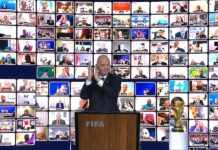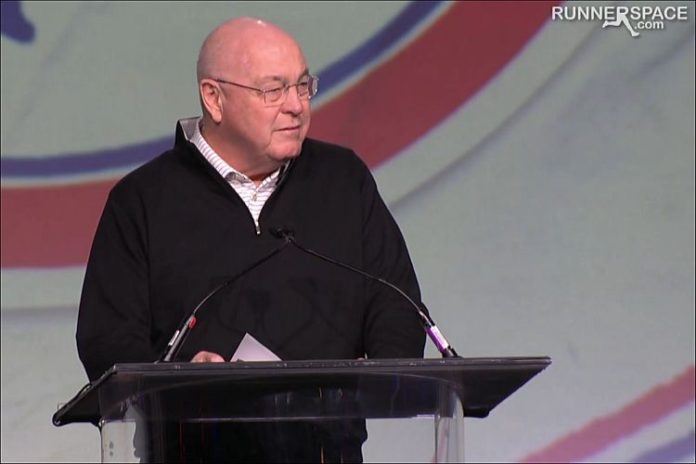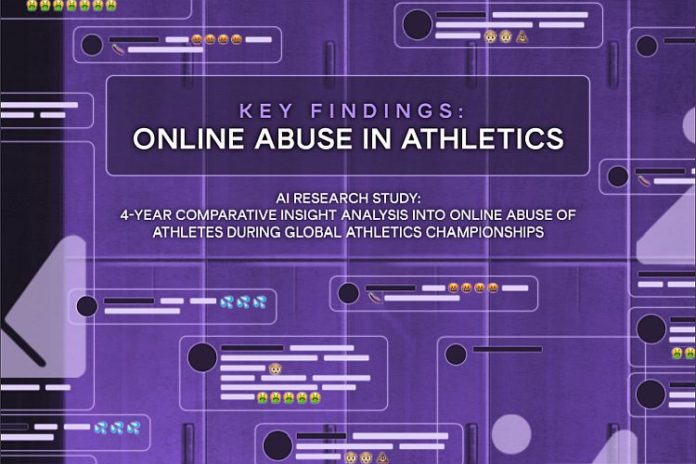★ The Sports Examiner: Chronicling the key competitive, economic and political forces shaping elite sport and the Olympic Movement.★
★ To get the daily Sports Examiner Recap by e-mail: sign up here! ★
≡ USTFCCCA CONVENTION ≡
“Simply put, our sports do not measure up in these areas.”
Very few people outside of the world of college cross country and track & field can tell you what “USTFCCCA” stands for, but the annual convention of the United States Track and Field and Cross Country Coaches Association is underway in Grande Lakes, Florida.
USTFCCCA chief executive Sam Seemes, the former LSU assistant coach and head of the 1992 U.S. Olympic Trials organizing committee, who has led the organization since 2005, told the attendees on Tuesday that unless significant change comes soon, collegiate track and field and cross country as they exist today may not exist in the future.
In a carefully-crafted, 11-minute opening address – in fact, 911 words, a perfect metaphor for essentially a “911″ emergency call – rang the alarm for these sports in view of the massive changes coming to all collegiate sport with the House vs. NCAA settlement that will channel about $20 million a year for the “Power Four” football schools to athletes, almost exclusively to football and basketball players. That means trouble for everyone else, and Seemes made this excruciatingly clear. Some highlights:
● “THREAT: Let me be blunt: Our sports are under siege. Not in some distant future, but right now. The threats are real and immediate:
“– Shrinking opportunities for student-athletes
“– Vanishing budgets
“– Disappearing scholarships
“– Reduced coaching positions
“– Complete program elimination
“– Replacement by sports perceived as more valuable
“If you think I’m being an alarmist, wake up. Every headline, every report, every analysis of collegiate sports points to an uncertain future for programs beyond football and basketball.
“How did we get here? Through collective inaction. While stakeholders buried their heads in the sand, our foundation eroded. University Presidents, tasked years ago with controlling athletic spending, instead accelerated it beyond sustainability. The NCAA and its membership, comfortable in its status quo, failed to adapt. And yes, we in track & field and cross country must look in the mirror – we’ve failed to position our sports for the future by resisting change at every opportunity.”
● “VALUE: The metrics of value in collegiate athletics have fundamentally shifted. Most of us entered coaching believing in the intrinsic value of mentoring young athletes, using sport as a vehicle for education and personal growth. These values – once the cornerstone of collegiate athletics – have been superseded by revenue generation, TV ratings, and marketability.
“Let’s be crystal clear: Nothing is guaranteed anymore. Our sport’s place in collegiate athletics is not a birthright. Yes, we have the highest participation numbers. Yes, we’re among the most diverse sports on campus. Yes, we produce exceptional graduation rates. But here’s the harsh reality – participation numbers and diversity statistics may make for good public relations, but behind closed doors, they’re not driving decisions.
“What’s driving these value decisions today? Let me be specific:
“– Media rights revenue
“– Donor engagement
“– Social media impressions
“– Attendance figures
“– Corporate sponsorship
“Simply put, our sports do not measure up in these areas.”
● “CHANGE: The path forward demands transformation. Not incremental adjustments, but fundamental change in how we conduct our sports. And let me be clear – change means changing. Not talking about change. Not planning to change. Actually changing NOW.
“I see some uncomfortable faces in the audience. Good. We should be uncomfortable. Comfort is what got us here.
“Consider this: While we’ve been conducting competitions the same way for years, other sports have revolutionized their presentation to become more consumable products for institutions and the public.
“I challenge each of you: Are you willing to commit to change for the betterment of our sports? Will you make decisions not just for your team or yourself, but for the collective future of track & field and cross country?
“If you’re waiting for your institution, conference, NCAA, USATF, USOPC, World Athletics, or Congress to fight this battle – stop waiting. They won’t save us. We must save ourselves.”
● “EXPOSURE: The first step toward survival is revolutionizing how we present our sports to the public. We must package our competitions in an engaging, consumable format that excites audiences and attracts broadcasters.
“Let’s be honest: All-day meets with endless time trials don’t engage the public and never will … nor with cross country meets with “tempo runs”. We need competitions with clear narratives, dramatic moments, and real stakes.
“The time for comfort is over. We’re not just competing with football and basketball anymore – we have been outmaneuvered by other sports in your athletic departments that have embraced change and adapted to modern demands.”
And Seemes did not stop there, adding an outline of what can be done:
“Our path forward is clear but challenging:
“1. We must create tangible value for our institutions
“2. We must implement meaningful change in how we operate
“3. We must prioritize the spectator and viewer experience
“4. We must revolutionize how we present our sport
“The choices ahead won’t be easy. They’ll require courage, creativity, and yes, compromise. I’m asking you to approach these challenges with an open mind – not just about what needs to change, but about how you personally can be part of that change.
“Smart choices rarely feel comfortable in the moment. They often require us to let go of what’s familiar, and that is not easy. But smart choices, made with careful consideration and an eye toward the future, are what our sport desperately needs right now.”
¶
Seemes provided one of the clearest looks yet at the plight of almost every college sports except football and basketball. What happens now is key, and the NBA just provided an example on Tuesday night.
In the second NBA Cup Final, played on a neutral court in Las Vegas, the Milwaukee Bucks beat the Oklahoma City Thunder, 97-81, to win the tournament, which was a new concept to increase interest in the NBA regular season, especially while NFL football still dominates the headlines.
It was a response to a problem of attention and interest by the NBA, which recognized an issue and did something about it.
Track & field and cross country have long had this problem and track, especially, has disappeared as a team sport thanks to brutal scholarship cuts, allowing 12.6 scholarships for each men’s team and 18 for women. That is changing dramatically with the House vs. NCAA settlement, if it goes through.
Assuming it does, schools will face new roster limits for each sport and can offer scholarships to all athletes on that roster. For cross country, the limits will be 17 for men and women, and for indoor and outdoor track, 45 for each, expected to begin with the 2025-26 academic year.
That’s a little more than the current average roster size for track & field, which is 39-40 at present. But what schools can afford to spend that much on cross country or track – schools will be permitted (but not required) to offer scholarships to all athletes – and while an Oregon could award 45 scholarships for cross country and track & field, who else in the Big 10 would follow?
Further, the roster sizes in track & field especially will limit what schools can do with walk-ons, who have filled in today’s rosters beyond the 12.6 men/18.0 women limits.
One way to address the issue of profile and notice is to bring back team scoring, whether on a dual, triangular or quadrangular basis, so fans will know who won and lost. Many a track coach has been asked, “did you win?” after a meet, and was unable to give a straight answer.
But Seemes has officially rung the warning bell, especially for track & field, which was the sport in which the first-ever NCAA Championship was ever held, in Chicago in 1921. A little more than a century later, the NCAA’s first championship sport could be one of the first to suffer in the era of professional college football.
¶
★ Receive our exclusive, weekday TSX Recap by e-mail by clicking here.
★ Sign up a friend to receive the TSX Recap by clicking here.
★ Please consider a donation here to keep this site going.
For our updated, 885-event International Sports Calendar for the rest of 2024, 2025 and beyond, by date and by sport, click here!

























